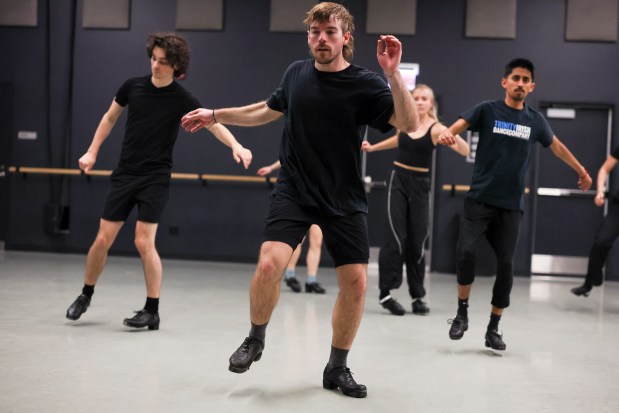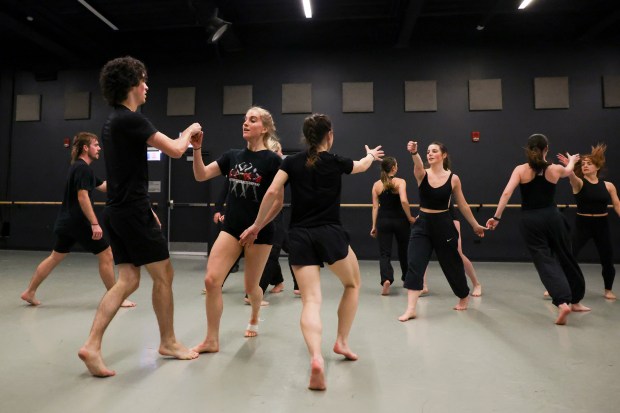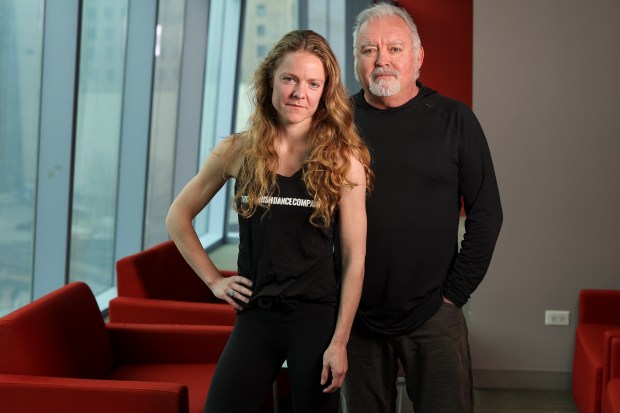The first time Mark Howard appeared on “The Tonight Show with Johnny Carson” was in 1989. Howard had been coaching teams to victory at the world championships for Irish step dancing — the first Americans to take home that trophy — and Carson took notice.
In Irish dance circles, Howard was most known for his figure dances, group pieces weaving 12-16 dancers through geometric jigsaw puzzles set to music of your choice, typically a reel, jig or hornpipe. But Irish step dance operates under strict sets of rules and regulations, and Howard wanted to do more.
“It’s a happy accident that Irish dancing ends up in a place where we’re trying to elevate it and stay true to the ancestors,” said Howard, who was introduced among Chicago dance types as “this traditional Irish dance guy from the barrio trying to win world titles for the United States.”
“And the next thing, I’m actually watching artists do what they do — and I wanted it. I wanted to be part of it,” he said.
Howard went to the Ruth Page Center for the Arts, where he saw Melissa Thodos perform the iconic “wheel” solo that spurred her company’s 25-year tenure. He went to MoMing, the city’s go-to hub for experimental modern dance. Hubbard Street Dance Chicago’s then-executive director Gail Kalver and prolific choreographer Harrison McEldowney championed Howard to build on his ideas about Irish dance as a performing art form. And in 1990, Trinity Irish Dance Company was born.
It’s not been the easiest road. After all, there’s no precedent for what Trinity does.
“The Illinois Arts Council at the time would have us relegated to an ethic category,” said Howard. “And I never could have seen the commercial thing coming.”
The “commercial thing” was “Riverdance,” the stage show that evolved into a billion-dollar behemoth spearheaded by another Chicagoan: Michael Flatley. The original touring production celebrated its 25th anniversary in 2020 and has been seen by more than 30 million people.
“That distraction is pretty huge, even today,” Howard said.
The franchise undoubtedly popularized and commoditized Irish dance, providing one pathway for dancers to have a career beyond competing. TIDC is another.
“We still say we’re not fully in the dance world,” said associate artistic director Chelsea Hoy. “You don’t grow up as an Irish dancer on a path to go into a professional company. There’s one place in the entire world where you can be part of a company and be there for who you are as an individual.”
Trinity Irish Dance Company’s 35 anniversary kickoff is an exemplar of their decades-long pursuit to both honor and elevate Irish dance. A new work, on view May 16-18 at the Museum of Contemporary Art Chicago, is “The Sash,” a collaboration choreographed by Hoy, Howard and Stephanie Martinez, artistic director of Chicago’s Para.Mar Dance Theatre.
It’s a revelatory fusing of Irish and contemporary dance, featuring guest dancer Taylor Yocum. The piece celebrates longtime company members Michael Fleck and Anna Gorman, leaders among this collective comprised of the world’s best Irish dancers. A featured duet highlights Yocum and Francisco Lemus, as fluent in tap as he is in Irish. And the third of three sections is Howard’s nod to the Irish figure dancing that started it all — performed barefoot. Working together was Martinez’s idea.

“I’ve always been a fan of the company, and I felt really connected to Fran,” said Martinez, referring to Lemus.
Martinez grew up near El Paso, Texas, along the U.S.-Mexico border. Lemus, from Puebla, broke boundaries of his own as the first Latin American to qualify for the final round of the world championships as a solo dancer.
“To make a collective work that celebrates how we’re alike — not how we’re different — that just felt important,” Martinez said. “I wanted to really explore the tenderness and resilience that’s in all of us.”
“The Sash” is designed as a companion piece for “Taking the Mick,” last year’s exploration of the Irish American experience through a vaudevillian lens. Here, Northern Irish composer Kevin Sharkey provides music inspired by a dream. Sharkey grew up with paramilitary troops parading through his hometown during the height of “The Troubles,” a bloody conflict between Ireland and Northern Ireland fueled by contempt between Catholics and Protestants. The dream imagines what might happen if those parades had been inspired by joy rather than hate.
“We’re not taking sides in this; it’s about togetherness, peace and love,” said Howard.
This summer, Trinity Irish Dance Company travels to Jacob’s Pillow, one of the country’s most revered dance festivals in Becket, Massachusetts. It’s the first time Irish dance has been presented on the festival’s mainstage, a theater named for the modern dance legend Ted Shawn, who founded the festival.
“We realized that Irish step dance has been underserved at the Pillow,” said director Pamela Tatge. “We thought about what company we should have to represent this form and its evolution. We could think of no company better than Trinity.”

At both the MCA and the Pillow, quintessential Trinity works like Howard’s “Soles” and “Push” are on the program, plus the company’s groundbreaking 2020 collaboration called “American Traffic,” created by Irish dance master Melinda Sullivan and Michelle Dorrance. Dorrance is also in Chicago this month working on a new piece for Trinity — her first solo project for the Irish dance company.
“They were unprecedented 35 years ago and are still singular now,” Dorrance said. “And that they believe, similar to so many of us tap dancers, in honoring this super rich and very niche tradition while also pushing themselves into new spaces—the fabric of that is everything I’m after. I’m inspired, challenged and invited to a place of such play when getting to work with those incredible dancers. That’s the dream.”
Lauren Warnecke is a freelance critic.
Trinity Irish Dance Company’s 35th anniversary celebration takes place May 16-18 at the Museum of Contemporary Art Chicago, 220 E. Chicago Ave. Tickets $40-$275 at tickets.trinityirishdancecompany.com



